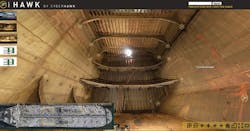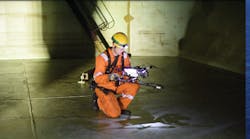UAVs bring offshore inspection into the digital age
Asthe oil andgas industry increasingly prioritizes digital innovation, many operators have yet to fully embrace asset integrity data as a means to drive decision making, optimize operations and maximize profitability. These operators are missing a vital opportunity to gather highly detailed, up-to-date data which will enhance the operation and production of their assets.
Pushing technology boundaries
Unmanned aerial vehicles (UAVs), otherwise known as drones, have taken inspection to a new level, allowing operators to undertake condition monitoring in a far more efficient manner. This is thanks to a range of benefits; inspections which are up to four times faster;cost savings of up to seven figures through avoiding unplanned shutdowns;and drastically reduced risk to the safety of personnel.
Cyberhawk says it has been using drones to inspect high, hazardous and difficult-to-reach assets for over a decade. Operating globally, typical general visual and close visual inspections include flares stacks, cooling towers, chimneys, confined spaces (such as the inside of a cargo tank) and structural inspections.
Cyberhawk says that its iHawk solution presents the client with a 360-degree view of the inside of the tanks, with defects and areas of interest highlighted.
In terms of internal tanks, drone inspections in these assets have to date focused on capturing visual data of specific areas, representing approximately 20 to 30% of the tank. Cyberhawk says it recently completed an inspection, however, using a solution developed to cover 100% of the tank’s internal surface in a quicker, more cost-effective manner.
The traditional method of inspection for this type of tanker would be to scaffold the inside of the tank, with surveyors performing a visual survey and non-destructive testing (NDT) technicians taking thickness measurements. There are multiple liabilities associated with this type of working, from potential dropped objects caused by lowering equipment into the tank, to potential damage to the tank coating, to working at height in confined spaces.
Furthermore, the time required to set up and remove the scaffold, together with the time required for inspection, is roughly seven days per tank compared to one day per tank by Cyberhawk’s two-man team, the company says.
Using data to its maximum potential
These types of technological advances allow greater volumes of data to be captured than ever before, opening the door to develop more efficient asset inspection programs. Generating these huge volumes of data, however, creates its own challenges and requires a different approach to reporting in order to get the best value out of the data.
In the previously highlighted tank inspection, Cyberhawk says that it completed more than 350 flights and collected over 600GB of data. The data is hosted in iHawk, Cyberhawk’s cloud-based visual asset management software, which has been designed to host the huge volumes of data captured by drones or other sources and allow the user to access this data in a functional and intuitive way.
UAVs allow operators to undertake condition monitoring in a far more efficient manner. (Images courtesy Cyberhawk)
iHawk presents the client with a 360-degree view of the inside of the tanks, with defects and areas of interest highlighted. High definition imagery was provided which allows the user to see these points of interest in greater detail, giving them the ability to make evidence-based asset management decisions.
The software presents one central repository of asset data that can be referred to by both projects teams and contractors, reduces visits required to site and means office-based staff have a better understanding of the tank and its context.
iHawk also provided the client with a complete visual record of the tank, which can be referred to on an ongoing basis to monitor the condition of the tank and the degradation of any defects.
Drones have already proven to be one of the most game-changing technologies when it comes to efficiency gains. By embracing the new opportunities presented by data management, operators can use data-driven insights to drive efficency, safety and reliability, fundamentally securing a competitive advantage in today’s evolving industry. •


